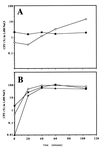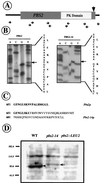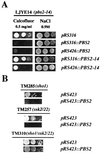Calcofluor antifungal action depends on chitin and a functional high-osmolarity glycerol response (HOG) pathway: evidence for a physiological role of the Saccharomyces cerevisiae HOG pathway under noninducing conditions
- PMID: 10762242
- PMCID: PMC111304
- DOI: 10.1128/JB.182.9.2428-2437.2000
Calcofluor antifungal action depends on chitin and a functional high-osmolarity glycerol response (HOG) pathway: evidence for a physiological role of the Saccharomyces cerevisiae HOG pathway under noninducing conditions
Abstract
We have isolated several Saccharomyces cerevisiae mutants resistant to calcofluor that contain mutations in the PBS2 or HOG1 genes, which encode the mitogen-activated protein kinase (MAPK) and MAP kinases, respectively, of the high-osmolarity glycerol response (HOG) pathway. We report that blockage of either of the two activation branches of the pathway, namely, SHO1 and SLN1, leads to partial resistance to calcofluor, while simultaneous disruption significantly increases resistance. However, chitin biosynthesis is independent of the HOG pathway. Calcofluor treatment also induces an increase in salt tolerance and glycerol accumulation, although no activation of the HOG pathway is detected. Our results indicate that the antifungal effect of calcofluor depends on its binding to cell wall chitin but also on the presence of a functional HOG pathway. Characterization of one of the mutants isolated, pbs2-14, revealed that resistance to calcofluor and HOG-dependent osmoadaptation are two different physiological processes. Sensitivity to calcofluor depends on the constitutive functionality of the HOG pathway; when this is altered, the cells become calcofluor resistant but also show very low levels of basal salt tolerance. Characterization of some multicopy suppressors of the calcofluor resistance phenotype indicated that constitutive HOG functionality participates in the maintenance of cell wall architecture, a conclusion supported by the antagonism observed between the protein kinase and HOG signal transduction pathways.
Figures






Similar articles
-
Unique and redundant roles for HOG MAPK pathway components as revealed by whole-genome expression analysis.Mol Biol Cell. 2004 Feb;15(2):532-42. doi: 10.1091/mbc.e03-07-0521. Epub 2003 Oct 31. Mol Biol Cell. 2004. PMID: 14595107 Free PMC article.
-
[Mechanism of HOG-MAPK pathway in regulating mycotoxins formation under environmental stresses].Sheng Wu Gong Cheng Xue Bao. 2022 Jul 25;38(7):2433-2446. doi: 10.13345/j.cjb.220060. Sheng Wu Gong Cheng Xue Bao. 2022. PMID: 35871615 Review. Chinese.
-
Interaction between the transmembrane domains of Sho1 and Opy2 enhances the signaling efficiency of the Hog1 MAP kinase cascade in Saccharomyces cerevisiae.PLoS One. 2019 Jan 25;14(1):e0211380. doi: 10.1371/journal.pone.0211380. eCollection 2019. PLoS One. 2019. PMID: 30682143 Free PMC article.
-
Adaptor functions of Cdc42, Ste50, and Sho1 in the yeast osmoregulatory HOG MAPK pathway.EMBO J. 2006 Jul 12;25(13):3033-44. doi: 10.1038/sj.emboj.7601192. Epub 2006 Jun 15. EMBO J. 2006. PMID: 16778768 Free PMC article.
-
Yeast go the whole HOG for the hyperosmotic response.Trends Genet. 2002 Aug;18(8):405-12. doi: 10.1016/s0168-9525(02)02723-3. Trends Genet. 2002. PMID: 12142009 Review.
Cited by
-
Role of the cell wall integrity and filamentous growth mitogen-activated protein kinase pathways in cell wall remodeling during filamentous growth.Eukaryot Cell. 2009 Aug;8(8):1118-33. doi: 10.1128/EC.00006-09. Epub 2009 Jun 5. Eukaryot Cell. 2009. PMID: 19502582 Free PMC article.
-
Specialization of the HOG pathway and its impact on differentiation and virulence of Cryptococcus neoformans.Mol Biol Cell. 2005 May;16(5):2285-300. doi: 10.1091/mbc.e04-11-0987. Epub 2005 Feb 23. Mol Biol Cell. 2005. PMID: 15728721 Free PMC article.
-
A genomic approach for the identification and classification of genes involved in cell wall formation and its regulation in Saccharomyces cerevisiae.Comp Funct Genomics. 2001;2(3):124-42. doi: 10.1002/cfg.85. Comp Funct Genomics. 2001. PMID: 18628907 Free PMC article.
-
Cinnamic Acid Analogs as Intervention Catalysts for Overcoming Antifungal Tolerance.Molecules. 2017 Oct 21;22(10):1783. doi: 10.3390/molecules22101783. Molecules. 2017. PMID: 29065462 Free PMC article.
-
Osmotic stress signaling and osmoadaptation in yeasts.Microbiol Mol Biol Rev. 2002 Jun;66(2):300-72. doi: 10.1128/MMBR.66.2.300-372.2002. Microbiol Mol Biol Rev. 2002. PMID: 12040128 Free PMC article. Review.
References
-
- Albertyn J, Hohmann S, Thevelein J M, Prior B A. GPD1, which encodes glycerol-3-phosphate dehydrogenase, is essential for growth under osmotic stress in Saccharomyces cerevisiae, and its expression is regulated by the high-osmolarity glycerol response pathway. Mol Cell Biol. 1994;14:4135–4144. - PMC - PubMed
-
- Brewster J L, de Valoir T, Dwyer N D, Winter E, Gustin M C. An osmosensing signal transduction pathway in yeast. Science. 1993;259:1760–1763. - PubMed
Publication types
MeSH terms
Substances
LinkOut - more resources
Full Text Sources
Molecular Biology Databases

